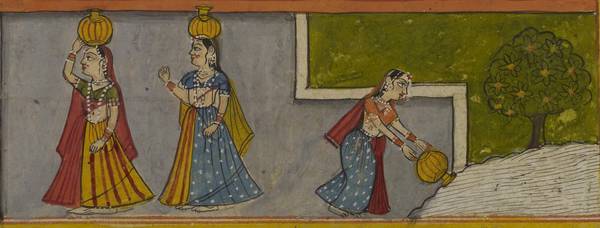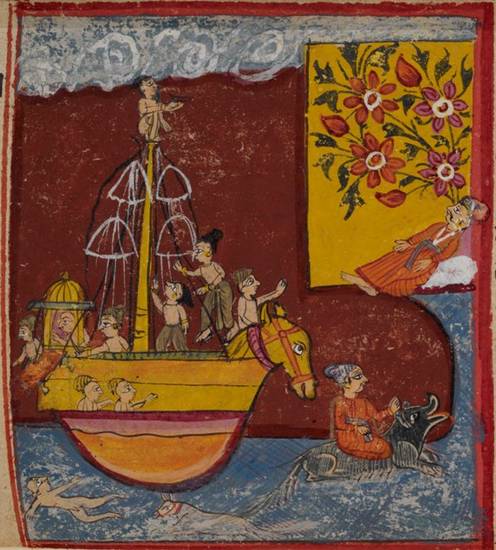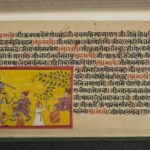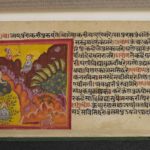Article: Mayṇāsundarī
The wife of King Śrīpal, Madanasundarī is the model wife of the Śvetāmbara Mūrti-pūjāk Jain satī tradition. She is usually called Mayṇāsundarī or Mainasundarī in modern versions of her story.
The story of Śrīpal and Mayṇāsundarī is widely known from the Śrīpal Rājā no Rās, written in Gujaratī by Vinaya-vijaya and Yaśo-vijaya in 1682. It is the basis of many forms of the story, which remains popular in the present day.
The tale of Śrīpal and Mayṇāsundarī is frequently re-enacted in rituals associated with the siddhacakra and the Āyambil Oḷī fast. The story forms the major element in the twice-yearly Āyambil Oḷī festival, which is chiefly associated with married women.
The tale of Mayṇāsundarī makes her the paramount model of a Jain woman. Her actions in the tale – revealing religious devotion, teaching proper religious practice to her family and readiness to accept wifely duties – create a happy and healthy family life after early difficulties. Even so, Mayṇāsundarī is not on the lists of satī, such the 16 satīs – soḷ satī – or those satīs listed in the Bharahesvar Bahubali Sajjhay. However, she is called a satī in all accounts and is widely named in Jain popular culture as a key virtuous woman.
Story of Śrīpal and Mayṇasundarī
Long ago in Ujjain, there were two sisters, Mayṇāsundarī and Sursundarī. They were the daughters of the two wives of King Prajāpāḷ of Ujjain. Mayṇāsundarī was raised as a Jain and Sursundarī as a Hindu.
When it was time for them to marry, King Prajāpāḷ let his daughters pick their husbands. Sursundarī chose a husband according to her taste and her father’s wishes, but Mayṇāsundarī refused. She gave her father a lecture on how she would be married to the husband that fate and karma selected. Prajāpāḷ became angry and decided to prove that it was he and not fate or karma that would determine his daughter’s destiny.
Marriage to the king of the lepers

Women fetching water
Image by British Library © CC0 1.0 (Creative Commons Public Domain)
Earlier, when a coup in Campa city had killed King Ajitsen, Queen Kamaḷprabhā and Prince Śrīpal had fled the palace. They found refuge hiding among a community of seven hundred lepers. Śrīpal caught leprosy and the lepers then named him their king.
Queen Kamaḷprabhā was a Jain and consulted a Jain monk, who assured her that her son would have a religious wife – a dharma patnī – and that his leprosy would go away.
Soon after Mayṇāsundarī’s refusal to choose a groom, Śrīpal and the seven hundred lepers arrived in Ujjain. The king invited Śrīpal, king of the lepers, to the palace and offered him Mayṇāsundarī in marriage.
Śrīpal said, “You should not marry such a beautiful girl to someone like me.”
But the king replied, “No – she said her karma will determine her fate, so she will marry you.”
Thus Śrīpal and Mayṇāsundarī were married.
Mayṇāsundarī’s mother was so upset that she left her husband and returned to her brother’s house. In her last conversatīon with Mayṇāsundarī, she told her to never give up her religion.
Mayṇāsundarī insisted on joining Śrīpal in the jungle with the lepers, rather than staying at home in the safety of the palace.
People began to speak scornfully of Jainism since it had led Mayṇāsundarī to show disrespect to her father and to marry a leper.
Navkār-mantra and fasting
After the wedding Mayṇāsundarī insisted that she and her new husband worship an image of Ṛṣabhanatha or Lord Ṛṣabha, the first Jina, and get the blessing of a Jain monk. When she performed the rite of worship a flower fell from the offering to the image into the folds of her sari, which was an auspicious sign.
After completing the ritual the couple went to seek the blessing of Candra-sūrijī.
Mayṇāsundarī told the monk, “People are saying bad things about Jainism because of my marriage to a leper.”
She asked the monk what she could do to help people understand the truth about Jainism and requested a mantra.
The monk told Mayṇāsundarī to recite the Navkār-mantra and to perform nine sets of nine āyambil fasting days twice a year. This would take four and a half years. “At the end of this fast,” he said, “you will see that your husband is a prince.”
Śrīpal and Mayṇāsundarī together performed this series of fasts, thereafter called the Navpad Oḷī fast or the Āyambil Oḷī fast. After they completed the fast Śrīpal was cured of leprosy. Then he was revealed to be not merely the king of the lepers, but Prince Śrīpal, son of King Ajitsen.
The water left over from their rites of worship was then used to cure all the other seven hundred lepers.
Religious faith is rewarded

Śrīpāla’s adventures
Image by British Library © CC0 1.0 (Creative Commons Public Domain)
After everyone was healed, Śrīpal and Mayṇāsundarī returned to his mother and touched her feet in a gesture of honour. Queen Kamaḷprabhā was thrilled to see her son healthy again and to meet her lovely and auspicious daughter-in-law.
When Mayṇāsundarī’s mother arrived she did not recognise her now-healthy son-in-law. She wept, ashamed that Mayṇāsundarī had brazenly taken a new husband. After she realised he was really Śrīpal, Queen Kamaḷprabhā told her the story of how Śrīpal had come to be a leper. Mayṇāsundarī’s mother insisted that they teach her husband he had been wrong to fault Jainism by showing him what a great husband Śrīpal had turned out to be.
Mayṇāsundarī then went to live in her uncle’s house with her mother-in-law, who loved her like a daughter, while Śrīpal sailed off to make his fortune.
While he was away Śrīpal had many adventures, during which his knowledge of the Navkār-mantra protected him. Aided by the mantra and his worship of the siddhacakra, Śrīpal achieved great wealth, and both he and Mayṇāsundarī enjoyed good health and happiness. They remained devoted to Jainism and, after eight happy lives as a married couple, Śrīpal and Mayṇāsundarī finally reached liberation.
References in Jain writings
There are numerous forms of the story of Śrīpal and Mayṇāsundarī, including songs, dramas and novel versions. The most widespread one is the 17th-century version by Vinaya-vijaya and Yaśo-vijaya. The availability of the story in modern technologies such as video and audio demonstrates its continued popularity.
‘Srīpal Rājā no Rās’
The tale is widely known from the Śrīpal Rājā no Rās, the version written in Gujarati by Vinaya-vijaya and Yaśo-vijaya in 1682. This extended epic poem is often recited as part of the daily sermons during the Āyambil Oḷī festival and festival participants must study it. The centrality of the tale in the Āyambil Oḷī festival and the links between the festival and the Navpad Pūjā account for much of the story’s popularity over the centuries.
Other written sources
The oldest known telling of Śrīpal and Mayṇāsundarī is Ratnaśekhara’s Prakrit-language Sīrivāla Kahā, composed earlier than 1372.
Since then, the story of Śrīpal and Mayṇāsundarī has been retold in medieval and modern hymns, contemporary novel forms, oral retellings, dramatic re-enactments, audio cassettes and video dramas. Most widely known is the set of hymns that accompanies the Navpad Oḷī fast and the Navpad Pūjā liturgies.
Related rituals
There are two clusters of rituals associated with the Śrīpal and Mayṇāsundarī story. The first is the Āyambil Oḷī festival and the fast in imitation of Mayṇāsundarī that lies at the heart of the festival. The second cluster is the liturgical ceremonies associated with the siddhacakra.
Ayambil Oḷi festival and fast
The term Āyambil Oḷī is the name of both a twice-yearly festival and the associated fast. Falling in the spring and autumn, the festival is characterised by nine consecutive Āyambil Oḷī fasts over its duration. These nine fasts form the Navpad Oḷī fast.
The Āyambil Oḷī festival centres on veneration of the siddhacakra, the re-enactment of Mayṇāsundari’s fast and the story of Śrīpal and Mayṇāsundarī. Married women vow to perform a nine-day āyambil fast in imitation of Mayṇāsundarī’s fast, with the intention of protecting their husbands’ health and promoting marital happiness and well-being. Mendicants will often retell the story of Śrīpal and Mayṇāsundarī, emphasising the theme of married happiness at the core of the festival.
Siddhacakra worship
All forms of worship of the siddhacakra are linked to the tale of Śrīpal and Mayṇāsundarī. The Siddhacakra Mahāpūjā is the ceremony of worship most prominently associated with the ritual cluster and its powers, because it is the one performed together by Śrīpal and Mayṇāsundarī after his miraculous healing. It is thus credited with having healing powers and bringing good fortune and marital contentment.
Reading
- Jains in the World: Religious Values and Ideology in India
John E. Cort - Oxford University Press USA; New York, USA; 2001
- Heroic Wives: Rituals, Stories and the Virtues of Jain Wifehood
M. Whitney Kelting - Oxford University Press USA; New York, USA; 2009
- ‘Negotiating Karma, Merit, and Liberation: Vow-taking in the Jain Tradition’
M. Whitney Kelting - Dealing with Deities: The Ritual Vow in South Asia
edited by Selva J. Raj and William P. Harman
State University of New York Press; Albany, New York, USA; 2006
- Riches and Renunciation: Religion, Economy and Society among the Jains
James Laidlaw - Oxford Studies in Social and Cultural Anthropology series
Oxford University Press; Oxford, UK; 1995
- Honour, Nurture and Festivity: Aspects of Female Religiosity amongst Jain Women in Jaipur
Josephine Reynell - PhD dissertation submitted to University of Cambridge in 1985
- ‘Religious Practice and the Creation of Personhood among Śvetāmbar Mūrtipūjak Jain Women in Jaipur’
Josephine Reynell - Studies in Jaina History and Culture: Disputes and Dialogues
edited by Peter Flügel
Routledge Advances in Jaina Studies series; volume 1
Routledge Curzon Press; London, UK; 2006
Links
- Story of Śrīpāḷa and Mayṇāsundarī
-
The Jain eWorld website provides the well-known tale of Śrīpāḷa and Mayṇāsundarī. The story illustrates that accepting karma, worshipping the siddhacakra or navapada and staying true to religious beliefs are crucial to being a good Jain and moving towards liberation. The tale is part of the epic Śrīpāḷ Rājāno Rās, which recounts Śrīpāḷa’s adventures after he is cured of leprosy. The story is a major element in the festival of Āyambil Oḷī, which focuses on religious devotion, especially revolving around the siddhacakra yantra, and marital happiness.
http://www.jaineworld.com/jain-stories/king-shripal-and-mayana-sundari/5/
- Siddhacakra
-
The siddhacakra or navapada is a flower with nine sections representing the Five Supreme Entities and the 'Four Jewels'. It is thus a visual summary of key elements of Jain belief. Often known as a navpad nowadays, the siddhacakra is a mystical yantra used in worship rites. This photo on Flickr shows a Śvetāmbara siddhacakra, with an ornately bedecked Jina in the centre.
- Sketch of a siddhacakra
-
This sketch of a siddhacakra is found in a manuscript held in the National Gallery of Australia. The Svetāmbara yantra or mystical diagram has nine parts, representing key elements of Jain doctrine. In the centre of the stylised lotus flower is a Jina and around him on alternating petals sit the other beings that make up the five highest beings. On the petals between them are phrases representing the 'four fundamentals'.
http://artsearch.nga.gov.au/Detail-LRG.cfm?IRN=157990&View=LRG
- Parts of a siddhacakra
-
Academic K. V. Mardia has created a diagram describing the different parts of a siddhacakra or navapada. The foremost Jain yantra, the siddhacakra summarises some of the holiest elements of the Jain religion.
The Yorkshire Jain Foundation in the UK provides a downloadable and printable PDF. You will need to have Adobe Acrobat Reader on your computer to open PDF files.
- Explaining the siddhacakra
-
Lay woman Heeral Shah explains the different elements of a siddhacakra mahā-yantra. Provided by the Victoria and Albert Museum in London, this video also includes a transcript.
http://www.vam.ac.uk/content/videos/p/video-painting-of-siddhachakra-yantra-heeral-shah/
- Siddhacakra mahāyantra
-
The Herenow4U website provides a picture of a siddhacakra or navapada mahā-yantra, the most popular yantra among contemporary Jains. This mystical diagram presents some of the main elements of Jainism. King Śrīpala and Queen Mayṇāsundarī, who are closely associated with it, are shown at the bottom demonstrating worship of the yantra.
- Navapada mahāyantra
-
The siddhacakra or navapada mahāyantra is the most popular Jain yantra, believed to be highly auspicious. It is a mystical diagram representing the major parts of the path to liberation from the cycle of rebirth. With a key role in worship rituals, the siddhacakra has a central position in the Āyambil Oḷī festival. The picture is found on the HereNow4U website.
- Sacred colours
-
Acharya Shri Shushil Muni explains the sacred colours of Jainism, which are found in several holy symbols, including the siddhacakra, the Namaskāra-mantra and the Jain flag. The information is provided by the Jainism Literature Center, associated with the Faculty of Arts and Sciences at Harvard University.
http://www.fas.harvard.edu/~pluralsm/affiliates/jainism/jainedu/colorscience.htm
- +
- aAbhavya
- aAbhinandana
- aAbhiṣeka
- aĀcāra
- aĀcārāṅga-sūtra
- aĀcārya
- aAchalbhrata
- aAḍhāī-dvīpa
- aAdharma
- aAdho-loka
- aAdhyayana
- aAdvaita Vedānta
- aĀgama
- aAghātīya
- aAghātīya-karman
- aAgnibhuti
- aAgra
- aĀhāra
- aAhiṃsā
- aAhimsa Day
- aAjita
- aAjīva
- aAkampit
- aĀkāśa
- aAkbar the Great
- aAkṣaya-tṛtīyā
- aAlauddin Khalji
- aAlbert Einstein
- aAllah
- aAlms
- aĀlocanā
- aAloka-ākāśa
- aAmāri
- aAmbikā or Kūṣmāṇḍinī
- aAnagāra
- aAnanta
- aAnarthadaṇḍa
- aAnaśana
- aAnekānta-vāda
- aAṅga
- aAniconism
- aAnojjā
- aAntarāla
- aAntarāya-karma
- aAṇu
- aAṇu-vrata
- aAnukampā
- aAnuprekṣā
- aAnusvāra
- aApabhraṃśa
- aAparigraha
- aAra
- aĀrambha
- aĀrambhaja
- aĀratī
- aArdhamāgadhī Prākrit
- aArhaṃ
- aArhat
- aArśana-āvaraṇīya-karma
- aĀrta-dhyāna
- aĀryikā
- aĀryikā Jñānamati
- aĀśātanā
- aĀścarya
- aAscetic
- aAsceticism
- aAshram
- aAspiration
- aĀsrava
- aAṣṭa-maṅgala
- aAṣṭāpada
- aAstikāya
- aAstrolabe
- aAsura
- aAtheism
- aAticāra
- aAtiśayakṣetra
- aAtithisaṃvibhāgavrata
- aĀtma-vāda
- aĀtman
- aAuṃ
- aAurangzeb
- aAuspicious
- aAusterity
- aAvadhāna
- aAvadhi-jñāna
- aĀvaraṇī-yakarman
- aAvasarpiṇī
- aAvatāra
- aAvidyā
- aAxiom
- aĀyāga-paṭa
- aĀyambil
- aĀyu-karma
- aĀyurveda
- bBabur
- bBāhubali
- bBaladeva
- bBālāvabodha
- bBandha
- bBasadi
- bBazaar
- bBhadrankarvijay
- bBhagavant
- bBhaktāmara-stotra
- bBhakti
- bBhale
- bBharata
- bBhāṣā
- bBhāṣya
- bBhaṭṭāraka
- bBhāva
- bBhāva-pūjā
- bBhāvanā
- bBhavana-vāsin
- bBhavya
- bBhavyatva
- bBhaya
- bBhoga-bhūmi
- bBhogopabhoga
- bBodhi
- bBollywood
- bBrahmā
- bBrahma-deva
- bBrahmacārī
- bBrāhmaṇa
- bBraj Bhāṣā
- bBright fortnight
- bBritish Raj
- bBuddha
- bBuddhi-sagar
- bBuddhism
- bBuddhist
- cCaitya
- cCaityavāsin
- cCakravartin
- cCakreśvarī
- cCāmara
- cCandanā
- cCandragupta
- cCandraprabha
- cCanon
- cCāritra
- cCāritramohanīya-karman
- cCarũrī
- cCaste
- cCaturvidha-saṅgha
- cCaturviṃśati-stava
- cCāturyāma
- cCE
- cCelibacy
- cCha
- cChadmastha
- cChastity
- cCheda-sūtra
- cChristian
- cChristianity
- cClergy
- cCloning
- cColophon
- cCommentary
- cConch
- cConfession
- cCongregation
- cConsecration
- cCosmology
- cCremation
- cCrore
- cCult
- cCūrṇi
- dDādā-guru
- dDalit
- dDāna
- dDaṇḍa
- dDark fortnight
- dDarśana
- dDarśanamohanī-yakarman
- dDaśa-lakṣaṇa-parvan
- dDeity
- dDelhi Sultanate
- dDerāsar
- dDeśāvakāśika-vrata
- dDetachment
- dDevanāgarī
- dDevānandā
- dDevarddhi-gani
- dDevotee
- dDhamal
- dDhanuṣ
- dDhāra
- dDharma
- dDharma-dhyāna
- dDharma-sāgara
- dDharmastikaya
- dDhātakīkhaṇḍa
- dDholak
- dDhyāna
- dDiaspora
- dDig-vrata
- dDigambara
- dDīkṣā
- dDisciple
- dDīvālī
- dDivya-dhvani
- dDNA
- dDoctrine
- dDogma
- dDonor
- dDoṣa
- dDravya
- dDravya-pūjā
- dDrone
- dDuṣamā
- dDuṣamā-duṣamā
- dDuṣamā-suṣamā
- dDveṣa
- dDvīpa
- eEast India Company
- eEightfold Path
- eEkānta-vāda
- eEkendriya
- eElder
- eElders
- eEschatology
- eEtc up to
- fFarmān
- fFast
- fFatehpur Sikri
- fFestival
- fFestschrift
- fFiruz Shah
- fFly-Whisks
- fFolio
- fFour Noble Truths
- gGaccha
- gGaṇa
- gGaṇadhara
- gGanadharavada
- gGaṇeśa
- gGaṇin
- gGarba
- gGarbha
- gGarbha-gṛha
- gGaruḍa
- gGati
- gGene
- gGenomics
- gGhātī-yakarman
- gGhātīya
- gGhaznavid
- gGhiyasuddin Tughlaq
- gGhurid
- gGloss
- gGotra-karma
- gGujarāt
- gGujarati
- gGuṇa
- gGuṇa-sthāna
- gGuṇa-vrata
- gGupti
- gGuru
- gGuruṇī
- hHagiography
- hHajj
- hHaṃsa
- hHaribhadra
- hHariṇaigameṣin
- hHasta
- hHeresy
- hHiṃsā
- hHindi
- hHindu
- hHinduism
- hHīravijaya
- hHoroscope
- hHrīṃ
- hHumayun
- hHymn
- iIconoclasm
- iIconography
- iIdol
- iIndian Independence
- iIndology
- iIndra
- iIndrabhūti Gautama
- iIndriya
- iInitiation
- iIntercession
- iInvocation
- iIQ
- iIslam
- iIslamicate
- iIṣṭadevatā
- iĪśvara
- jJagat
- jJahangir
- jJain
- jJaina Devanāgarī
- jJaina Śaurasenī
- jJaina-dharma
- jJainaśāsana
- jJainness
- jJaisalmer
- jJamāli
- jJambū-dvīpa
- jJames Burgess
- jJanma
- jJanma-kalyāṇa
- jJarā
- jJāti
- jJina
- jJina-āgama
- jJina-bhavana
- jJina-bimba
- jJina-mātā
- jJinacandra-sūri
- jJinadatta
- jJinaprabha
- jJīva
- jJñāna
- jJñāna-āvaraṇīya-karma
- jJñāna-āvarṇiya
- jJñānsundar
- jJyotiṣka
- kKāla
- kKālakācārya-kathā
- kKālidāsa
- kKalpa-sūtra
- kKalpa-vṛkṣa
- kKalyāṇaka
- kKalyanvijay
- kKamaṇḍalu
- kKamaṭha
- kKarma
- kKarma-bhūmi
- kKarma-grantha
- kKarma-prakṛti
- kKarma-vāda
- kKarmon
- kKarnataka
- kKaṣāya
- kKathā
- kKāvya
- kKāya
- kKāyotsarga
- kKeśa-loca
- kKetu
- kKevala-jñāna
- kKevalin
- kKhalji
- kKharatara-gaccha
- kKnowledge
- kKriyā
- kKriyā-vāda
- kKṛṣṇa
- kKṣamā-śramaṇa
- kKṣapakaśreṇi
- kKṣatriya
- kKṣullaka
- kKulakara
- kKundakunda
- kKunthu
- lLabdhi
- lLaity
- lLakh
- lLāñchana
- lLands of Action
- lLaukāntika
- lLavaṇa-samudra
- lLeśyā
- lLiṅga
- lLinguistics
- lLoka
- lLoka-ākāśa
- lLoka-puruṣa
- lLoka-vāda
- lLotus
- lLotus lake
- mMadhya-loka
- mMahā-videha
- mMahā-vrata
- mMahābhārata
- mMahāmastakābhiṣeka
- mMāhārāṣṭra
- mMāhārāṣṭrī Prākrit
- mMahattarā Yākinī
- mMahāvīr Jayantī
- mMahāvīra
- mMakāra
- mMakkhali Gośāla
- mMalli
- mMāna-stambha
- mManaḥ-paryāya-jñāna
- mMaṇḍala
- mMaṇḍapa
- mMandit
- mMaṅgala
- mMantra
- mMantras
- mManuṣya-loka
- mMarāṭhī
- mMārgaṇā
- mMartyr
- mMarudevī
- mMaṭha
- mMati-jñāna
- mMauryaputra
- mMecca
- mMendicant lineage
- mMetarya
- mMiracle
- mMithyādṛṣṭi
- mMohandas Gandhi
- mMohanīya-karma
- mMokṣa
- mMonastic order
- mMonasticism
- mMonk
- mMonotheism
- mMosque
- mMount Meru
- mMount Sammeta
- mMṛgāvatī
- mMughal
- mMuhammad
- mMuhammad bin Tughlaq
- mMuhpattī
- mMūla-sūtra
- mMūlaguṇa
- mMumbaī
- mMuni
- mMunisuvrata
- mMurad Bakhsh
- mMūrti-pūjaka
- mMuslim
- mMysticism
- nNābhi
- nNāga-kal
- nNāgapurīya Tapā-gaccha
- nNāgarī
- nNāma-karma
- nNamaskāra-mantra
- nNami
- nNandīśvara-dvīpa
- nNandivardhana
- nNandyāvarta
- nNāraka
- nNāraki
- nNasalisation
- nNātha
- nNavrātrī
- nNaya-vāda
- nNemi
- nNidāna
- nniggaṃthāṇa vā 2
- nniggaṃtho vā 2
- nNigoda
- nNihnava
- nNikṣepa
- nNirgrantha
- nNirjarā
- nNirvāṇa
- nNiryukti
- nNiṣidhi
- nNitya
- nNiyati
- nNo-kaṣāya
- nNudity
- nNun
- oOcean of milk
- oOmniscience
- oOrdination
- ppa°
- pPadmaprabha
- pPadmāsana
- pPadmāvatī
- pPādukā
- pPalanquin
- pPalette
- pPañca-muṣṭi
- pPāṇḍava
- pPaṇḍit
- pPandit Dalsukh D. Malvania
- pPandit Sukhlalji
- pPāṇipātra
- pPāpa
- pParamātman
- pParameṣṭhin
- pPāraṇā
- pParigraha
- pPariṇāma
- pParīṣaha
- pParokṣa
- pPārśva
- pPārśvanātha
- pParyāya
- pParyuṣaṇ
- pPaṭa
- pPatan
- pPātra
- pPenance
- pPersian
- pPhala
- pPhilology
- pPicchikā
- pPilgrimage
- pPīr
- pPolymath
- pPoṣadha
- pPossession
- pPothī
- pPrabhas
- pPradakṣiṇā
- pPradeśa
- pPrākāra
- pPrakīrṇaka-sūtra
- pPrākrit
- pPramāda
- pPramukhā
- pPrati-vāsudeva
- pPratikramaṇa
- pPratimā
- pPratiṣṭhā
- pPratyākhyāna
- pPratyakṣa
- pPravacana
- pPrāyaścitta
- pPrayer
- pPre-modern
- pPreach
- pPredestination
- pProtestant
- pProvenance
- pPudgala
- pPūjā
- pPujārī
- pPukharavara-dvīpa
- pPuṇya
- pPūrva
- pPuṣkara-dvīpa
- pPuṣpadanta
- pPyre
- qQur’an
- rRāga
- rRāhu
- rRainy season
- rRajasthan
- rRajasthani
- rRājimatī
- rRajoharaṇa
- rRajput
- rRāma
- rRāmāyaṇa
- rRangoli
- rRās-garbā
- rRasa
- rRathanemi
- rRatna-traya
- rRātri-bhojana
- rRaudra-dhyāna
- rRecto
- rRelic
- rRenunciation
- rRetroflex
- rRevatī
- %Ṛg-veda
- rRite
- rRosary
- %Ṛṣabha
- %Ṛṣabhanātha
- rRupee
- sSaciyā Mātā
- sSādhu
- sSādhvī
- sSāgāra
- sSaint
- sŚaivaism
- sŚaka-saṃvat
- sSallekhanā
- sŚalya
- sSamacatuṣṭha
- sSamādhimaraṇa
- sSamaṇi
- sSāmarambha
- sSamavasaraṇa
- sSāmāyika
- sSaṃbhava
- sSamiti
- sSaṃjñā
- sSaṃkalpaja
- sSaṃsāra
- sSamudghāta
- sSaṃvara
- sSaṃvega
- sSamyak-cāritra
- sSamyak-darśana
- sSamyak-jñāna
- sSamyaktva
- sSaṃyama
- sSanctuary
- sSandalwood
- sSaṇgha
- sSanskrit
- sSant
- sŚānti
- sSapta-bhaṅgi-naya
- sSārambha
- sSarasvatī
- sSarvajña
- sSāsan-devi
- sŚāsana-devatā
- sŚāstra
- %Ṣaṭ-jīvanikāya
- sSatī
- sSatīmātā
- sSatya
- sSchism
- sScribe
- sScripture
- sSect
- sSecularism
- sŚenāī
- sSermon
- sŚeṣavatī
- sSevā
- sSeven fields of donation
- sShah Jahan
- sShantidas Jhaveri
- sShrine
- sSiddha
- sSiddha-śilā
- sSiddhacakra or Navadevatā
- sSiddhānta
- sSiddhārtha
- sSiddhi
- sSikh
- sSikhism
- sŚikṣā-vrata
- sŚīla
- sSin
- sSindh
- sŚītala
- sŚiva
- sSkandha
- sSomanatha
- sŚraddhā
- sŚramaṇa
- sŚrāvaka
- sŚrāvakācāra
- sŚrāvikā
- sŚreyāṃsa
- sŚrī
- sŚrīvatsa
- sŚruta-jñāna
- sŚruta-pañcamī
- sSthānaka-vāsin
- sSthāpanācārya
- sSthāvara
- sSthavira
- sSthiti
- sStrīmukti
- sStūpa
- sSubcontinent
- sSudarshana
- sŚuddhi
- sSudharma
- sŚūdra
- sSufism
- sSukha
- sŚukla-dhyāna
- sSulasā
- sSultan
- sSumati
- sSundarśrī
- sSupārśva
- sSūri
- sSuṣamā
- sSuṣamā-duṣamā
- sSuṣamā-suṣamā
- sSūtra
- sSuyam me ausam! Tenam bhagavaya evamakkhayam
- sSvādhyāya
- sSvāhā
- sSvastika
- sŚvetāmbara
- sŚvetāmbara Terāpanthin
- sŚvetāmbaras
- sSwan
- sSyād-vāda
- tTabla
- tTantra
- tTapā-gaccha
- tTapas
- tTāraṇ Svāmī Panth
- tTattva
- tTattvārtha-sūtra
- tTemple
- tTemple-city
- tThe Enlightenment
- tTheology
- tThree worlds
- %Ṭīkā
- tTilaka
- tTīrtha
- tTīrthaṃkaranāma-karman
- tTīrthankara
- tTransliteration
- tTrasa
- tTrasa-nāḍī
- tTriśalā
- tTriṣaṣṭi-śalākā-puruṣa-caritra
- tTti bemi
- tTughlaq
- tTunk
- uUdumbara
- uUniversal History
- uUpādhyāya
- uUpāṅga
- uUpaniṣads
- uUpāsaka
- uUpasarga
- uUpāśraya
- uŪrdhva-loka
- uUtsarpiṇī
- uUttarādhyayana-sūtra
- vVāhana
- vVaimānika
- vVairāgya
- vVaiṣṇava
- vVaiśramaṇa
- vVaiśya
- vValabhī
- vVanaspatikāya
- vVandana
- vVaṇik
- vVarṇa
- vVāsudeva
- vVāsupūjya
- vVayubhūti
- vVeda
- vVedanīya-karma
- vVegetarianism
- vVehicle
- vVernacular
- vVerso
- vVidyā
- vVidyā-devī
- vVihāra
- vVijñapti-patra
- vVikrama-saṃvat
- vVikṛti
- vVimala
- vVinaya
- vVipāka
- vVirji Vora
- vVirodhaja
- vVīrya
- vVisarga
- vViṣṇu
- vVītarāga
- vVizier
- vVotive
- vVow
- vVrata
- vVS
- vVyakta
- vVyantara
- vVyasana
- yYakṣa
- yYakṣī
- yYantra
- yYaśoda
- yYaśovijaya
- yYati
- yYātrā
- yYoga
- yYoginī
- yYojana









